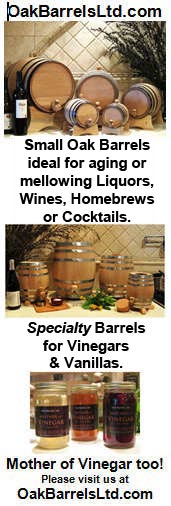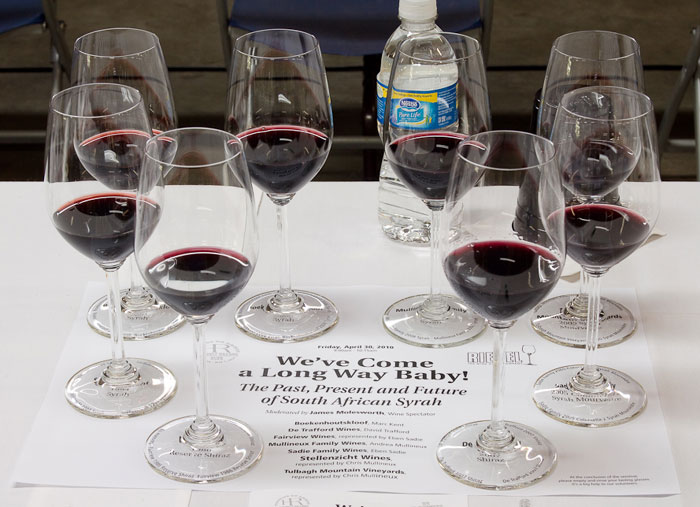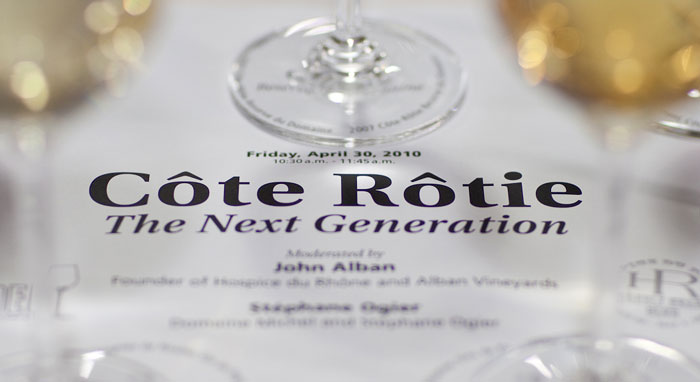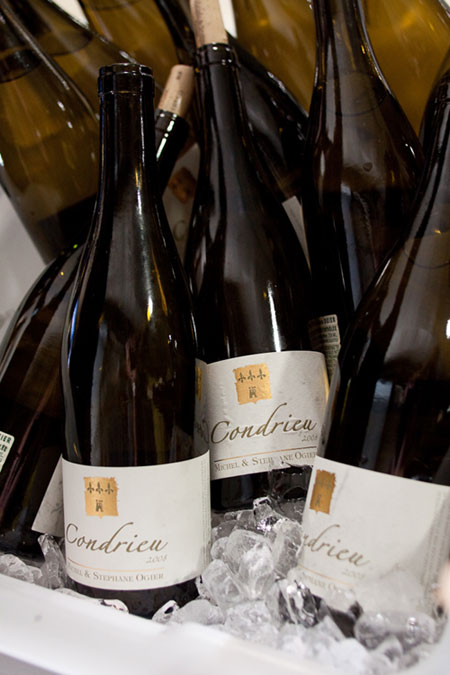Hospice du Rhone 2010 Friday Seminars – S. African Syrahs and Cote Rotie
Both Friday seminars are presented in this post:
“We’ve Come a Long Way Baby!
The Past, Present and Future of South African Syrah”
One of the best things about Hospice du Rhone is the world-wide focus of the event. Sure, domestic wines are front and center, especially from the Central Coast, but HdR has always celebrated the WORLD of Rhone varietals, both here, their home in France, and in all of the wine-producing countries in the world. So it was appropriate that HdR 2010’s seminar lineup kicked off with an in-depth look at South Africa, one of the oldest wine-growing regions, and yet one of the newest, too, particularly as a producer of high quality Rhone varietals and blends.
Winemaking in South Africa goes all the way back to the 17th century, when grapes were first planted at the estate now known as Groot Constantia. Wines from South Africa were prized in Europe throughout the 18th and 19th centuries, but fell into disfavor as the evils of apartheid resulted in world-wide boycotts of South African products. Cut off from exposure to the wines of Europe (as well as its markets), the winemakers in South Africa turned inward and were essentially stunted in their growth. With effectively no competition, the South African wine industry focused on quantity over quality, producing large quantities of very mediocre wines solely for domestic consumption. A large cooperative (KVW) controlled production and distribution, and there was no incentive to produce anything of sufficient interest to compete in the world wine market. And that’s where things stood until the late 1980’s.
With the coming of the end of apartheid, and its eventual demise in 1994, South Africa’s wine industry underwent a virtual revolution, and the winemakers on the panel made a point to explain that pre- and post-apartheid wines in South Africa are completely different animals. In particular, pre-apartheid wines focused mainly on white varietals, especially chenin blanc and fortified wines, whereas the development since then have been mainly in red varietals. An no red varietal has grown more in popularity, and acreage planted than syrah (usually, but not always, called shiraz in SA). From virtually none planted before 1990, syrah now represents nearly 10% of all planted wine grapes, and is second only to Cabernet as the most popular red varietal. Other Rhone varieties like Grenache and Mourvedre have much smaller plantings, but are growing yearly.

Left: Andrea Mullineaux, James Molesworth (moderator), David Trafford, Mark Kent, Eben Sadie, Chris Mullineaux. Click to enlarge - Photo courtesy: MelHill.com
Five prominent South African winemakers and winery principals made the long trek to Paso Robles to present a very interesting array of South African Rhone-based wines, both current releases and some more aged examples. David Trafford represented De Trafford Wines; Mark Kent represented Boekenhoutskloof; Eben Sadie showed his eponymous wine and also presented the Fairview Shiraz; and Andreas and Chris Mullineaux presented Mullineaux Family, Stellenzicht and Tulbagh Mountain Vineyards. The wines seemed well chosen to provide a good sense of the state of South African Syrah winemaking.
1986 Fairview Reserve Shiraz (Paarl). This historic wine was one of the first varietal syrah wines ever bottled in South Africa. Grown on primarily granite soils with some clay, aged in small oak barrels, 12.5% alcohol. A rather brown color, clearly showing considerable age. Earthy/herbal nose with some green notes, a hint of oxidation. Palate is quite earthy and bit vegetal, with mushrooms and forest floor dominating, seemingly rather tired now, but still interesting with a smooth, rich texture and good balance of acids and tannin. Could pass for a very old Bordeaux from a mid-level estate in some ways. Still drinking, if well past its best, and a fascinating glimpse of “apartheid-era” winemaking. Find this wine
1994 Stellenzicht Syrah (Stellenbosch). Grown on shale and sandstone. Much fresher, with a slight hint of menthol adding complexity to cherry fruit scents. Quite tart with high acid near the limit for enjoyment, the palate shows floral and cherry-vanilla flavors, seemingly of American oak. Clean and fresh, very high-toned stopping just short of shrill, a pleasant but rather simple wine that’s probably as good as it’s going to get. Find this wine
2001 Boekenhoutskloof Syrah (Paarl). The 4th vintage of this now famous wine, generally regarded as one of South Africa’s best syrahs. Raised in all used French oak for 18 months. The nose is quite complex with both floral and animale notes of classic syrah. Very bright palate with firm acids accenting an interesting blend of floral and earthy/mushroom flavors with hints of cherry, tobacco and leather. Seems mature with some warm earthy/brown/mahogany aspects of a fully mature wine, but quite nice and drinking very well now. Find this wine
2006 Boekenhoutskloof Syrah (Paarl). Much deeper fruit and riper, too, but with the same firm acidity of its older brother. The ripeness shows in some licorice, blackberry and plum, and the density is much greater than the 2001. Smooth but grippy tannins, with a very long pleasant finish. Unlike the 2001, this wine was made in concrete. Very nice. Find this wine
2008 Mullineaux Family Syrah (Swartland). Grown in schist and granite. Very deep, ripe and strongly marked by what tastes like American oak. Ripe, black fruits with very sharp acids which help support the richness and add a citric note. Plenty of pepper and licorice, firm tannins. This will need some time and seems promising. Find this wine
2005 Tulbagh Mountain Vineyards Syrah Mourvèdre (Tulbagh). A blend of 80% Syrah and 20% Mouvèdre, 14.5% alcohol, grown on shale and schist. Rather closed on the nose, not showing much. But the palate is full of spicy fruit, firm acids and complex fruits like raspberry, cherry, and some citrus like tangerine. Really nice balance and a mouthwatering quality from the acids (3.2pH) that are strong but not dominant, good weight and a long finish. Very nice wine that shows good potential for development. Find this wine
2005 Sadie Family Columella 2 Syrah Mourvèdre (Swartland). Also 80% Syrah, 20% Mourvèdre, grown on granite, slate and clay. Rich, ripe deep nose with spice and American oak/vanilla. Quite ripe and oaky, but with firm acids that keep the wine from seeming ponderous. Some citrus notes with the cherry/raspberry fruit, and some plum/black fruit notes. A hint of VA adds a disjointed note that suggests the need for more bottle age. Rather “international” in style compared to some of the other wines. Find this wine
2007 De Trafford Shiraz (Stellenbosch). The ripest wine yet at 15% alcohol, but not at all overripe or pruney. Very deep, rich fruit with excellent balance, good acidity a bit lower than some of the other wines, but still quite firm and without any citric notes. Both red and black fruits with hints of florals and spice, as well as licorice. A very complex and complete wine, and the best balanced. My favorite wine of the tasting. Find this wine
This was a very enjoyable tasting and also one of the most interesting of the last few years. I enjoyed the style of most of these wines quite a bit. In general, the style is quite a bit leaner and higher-toned than most domestic or French syrahs, with the emphasis on crisp acids, pure fruit flavors, and moderate use of oak. There was little of the funkier side of syrah in the modern wines, not much barnyard or earthier/leathery notes. At this point the wines come across as a bit simpler and more direct than the finer producers can achieve in the Rhone or in California, without the complexity or layers of flavor that the finest wines of these varietals can produce. Although at least one panelist indicated that Australia had been somewhat of a model for the making of syrah, I found none of the ultra-ripe style common in Barossa and other hot-weather regions in Australia, and all of the winemakers stated that their high acidity was achieved without acidification. As a result, these wines strike me as successful in terms of developing a unique South African identity, which is clearly the aim of all of the winemakers who were present at the seminar. These are wines, and a country, to watch!
Côte Rôtie, The Next Generation
The second seminar on Friday focused on one of the Rhone’s greatest appellations: Côte Rôtie. The featured producer was Domaine Ogier, and the current generation now in charge was well represented by the charming Stephane Ogier. The Ogier family has been growers in the region for seven generations, but they have only been wine producers since 1982. In a sense they were forced into making their own wine, as during a time of glut their grapes were rejected by “certain large negotiants”. Both of Stephane’s parents were born in Ampuis, and their knowledge of, and connections in the area are deep and have allowed them to develop vineyards both within the most prestigious appellations of Condrieu and Côte Rôtie, but also in some nearby plots that are outside the normal appellations (and are thus entitled only to a Vin de Pays designation) but which offer some of the qualities of the more prestigious cuvees.
The tasting featured most of the current offerings of Domaine Ogier as well as one more mature wine. Two of the wines intended for the tasting didn’t make it for reasons that weren’t entirely clear. There were a number of jokes about how the Icelandic volcano had prevented their shipment, or that some truck driver in middle America was drinking very well right about now. Nevertheless, the remaining wines gave a very complete picture both of the wines that Ogier is now producing, and of the characteristic of some of the Rhone’s most important appellations.
2008 Viognier de Rosine (Vin de Pays). From a single vineyard about a mile from Condrieu. Bright floral and peach on the nose. Exceptionally crisp with high acidity but ample backing fruit on the palate. Citrus dominating with some savory herbs all wrapped in a lighter body than most viogniers. Less peach/apricot and more citrus flavors with outstanding energy and freshness. Has an Alsatian-like crispness (old-school Alsace anyway, without residual sugar), and great purity. This should be very versatile with food. Find this wine
2008 Condrieu. Ogier’s second vintage of this wine, from a 1.2 acre plot purchased in 2007, but with 15-year old vines planted in granite soil. Much richer and rounder than the Rosine, and with more complexity on the nose. Piercing acidity and intense minerality, and a hint of something green that reminded me of a Gruner Veltliner (green bean?). Full of stones, and a bit of pit fruit, very concentrated yet perfectly balanced. A spectacular Condrieu that seems like it should age beautifully despite the reputation of the appellation as a wine to drink young. Find this wine
2007 L’Ame Soeur (Syrah, Vins de Pays). The name literally means “soul sister,” but the idiom really means something more like soulmates. The nose is all violets, with hints of green olive. There’s sharp, intense acidity at first, seems a bit thin and more green olive on the palate. Medium body with ample but smooth tannins, showing very high-toned red fruits. This wine emphasizes finesse over power, rather simple but very pretty. Find this wine
2007 Côte Rôtie, Lancement. From the Côte Blonde, planted in light schist soil in 2001. Completely destemmed. Very complex spice, violets and licorice nose. Beautiful round and elegant mouthfeel, full of finesse and depth, with high-toned red and blue fruits and floral notes (violets again). No taste of the 40% new oak. Young but already delicious and showing great complexity. Very feminine and elegant, but with intense flavors. Drinkable now, but the balance is there for long aging, and you know it will only improve. Find this wine
2007 Côte Rôtie Belle-Helene. From the Côte Brune, a plot tended by Ogier’s grandfather from 70 years ago. 15% stems included. Much darker and brooding nose, more black fruits and licorice. Firmer, larger-scaled structure with grippier tannins and firm acids. Seems riper, and definitely a richer wine with darker fruit flavors, not yet fully developed. The Lancement could be enjoyed now, but this one really needs more time. Find this wine
2001 Côte Rôtie Reserve du Domaine. A blend of wines from both Côte. Seems mature on the nose and showing some barnyard notes. Very open and full, with minerality and some band-aid/bretty flavors as well. This is more earthy, and the primary fruit is mostly resolved. Seems quite mature, with even a hint of oxidation appearing after an hour. Reasonably complex, but not as impressive as the 2007 single-vineyard cuvées. Find this wine
2005 Roussanne (Vins du Pays). Not really a Vin du Paille, but a late-harvest, dry Roussanne blended from all of Ogier’s vineyards. Only 125 cases made, not yet available in the USA. Quite toasty, nutty and full of crème brulée flavors, and a hint of something Alsatian—almost like the diesel/petrol scents found in Riesling, but more varnishy. The color, nose and flavors make you think this should be sweet, but it’s not. Very intense and penetrating, and with excellent balance, but frankly this is more interesting on an intellectual level than really enjoyable to my palate. A rather odd wine, hard to know what food this would work with, perhaps blue cheese? Find this wine
This was a fabulous seminar. Ogier was a terrific speaker, very likeable and down-to-earth, and he really charmed the attendees. I hadn’t had much experience with Ogier’s wines before, but after this seminar they are wines I will seek out. I was especially impressed by the whites, their purity, precision and balance were exceptional, much leaner and more complex than most domestic white Rhone varietals and blends. The Côte Rôtie were, well, Côte Rôtie—one of the world’s greatest wines. If the 2001 seemed a bit tired (not sure how long it had sat in the glass before the seminar began), the 2007’s show great promise and outstanding quality. It would appear that “the next generation” in Côte Rôtie has things well in hand.
Photos courtesy MelHill.com









Wonderful website. Lots of useful info here. I am sending it to
a few pals ans also sharing in delicious. And obviously, thank
you oon your sweat!
Wines to watch.Gang of Pour on the SA syrahs poured at Hospice du Rhone 2010 http://bit.ly/cCOSKO
Hospice du Rhone 2010 Friday Seminars – S. African Syrahs and Cote Rotie http://bit.ly/chJgv6 #wine